I would like to be remembered as a person who wanted to be free… so other people would be also free.
Rosa Parks (1913—2005)
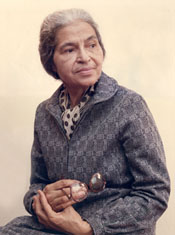 Rosa Parks was born in Tuskegee, Alabama in 1913, of African-American, Cherokee–Creek, and Scots-Irish descent. Her father was a carpenter, and her mother a teacher. “Back then, we didn’t have any civil rights. It was just a matter of survival, of existing from one day to the next,” Parks has said. “I remember going to sleep as a girl hearing the Klan ride at night and hearing a lynching and being afraid the house would burn down.”
Rosa Parks was born in Tuskegee, Alabama in 1913, of African-American, Cherokee–Creek, and Scots-Irish descent. Her father was a carpenter, and her mother a teacher. “Back then, we didn’t have any civil rights. It was just a matter of survival, of existing from one day to the next,” Parks has said. “I remember going to sleep as a girl hearing the Klan ride at night and hearing a lynching and being afraid the house would burn down.”
Later, however, Parks wrote: “I have learned over the years that when one’s mind is made up, this diminishes fear; knowing what must be done does away with fear.”
In 1932 Rosa married Raymond Parks, a barber and civil rights activist, who encouraged her to return to high school and earn her diploma, which she did in 1933, at a time when fewer than 7% of African Americans had a high school diploma. The couple went to live in Montgomery, Alabama, where Parks was employed as a domestic worker and seamstress and also became a member of the Montgomery chapter of the National Association for the Advancement of Colored People (NAACP) in 1943, serving as its secretary until 1956. In the 1940s, Parks and her husband were members of the Voters’ League and Parks repeatedly attempted to register to vote (on the one day a year when the office was opened to African-American citizens), finally succeeding on her third try—an unusual and determined act which presaged her famous gesture of dignity and defiance on December 1, 1955.
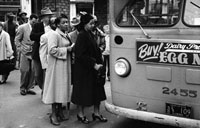 In a now legendary incident, Parks peacefully but staunchly refused to give up her bus seat to a white man. She had been seated in the middle section of the bus, designated “colored”: when the “white-only” section at the front became full, the driver (James F. Blake) moved the “colored” sign back a row in order to create new seats for his white passengers. The driver ordered Parks and three other African-American passengers to stand and vacate their seats; Parks’ three neighbours complied, but Parks remained seated. “Why don’t you stand up?” the driver asked, and Parks responded, “I don’t think I should have to stand up.” The driver threatened to call the police and have Parks arrested, whereupon she informed him, “You may go on and do so.”
In a now legendary incident, Parks peacefully but staunchly refused to give up her bus seat to a white man. She had been seated in the middle section of the bus, designated “colored”: when the “white-only” section at the front became full, the driver (James F. Blake) moved the “colored” sign back a row in order to create new seats for his white passengers. The driver ordered Parks and three other African-American passengers to stand and vacate their seats; Parks’ three neighbours complied, but Parks remained seated. “Why don’t you stand up?” the driver asked, and Parks responded, “I don’t think I should have to stand up.” The driver threatened to call the police and have Parks arrested, whereupon she informed him, “You may go on and do so.”
Many accounts imply that the petite Rosa Parks remained in her seat because she felt weak and tired, after a long day at work, but, as she emphatically clarified, this was not her motivation: “I was not tired physically, or no more tired than I usually was at the end of a working day. I was not old, although some people have an image of me as being old then. I was forty-two. No, the only tired I was, was tired of giving in.”
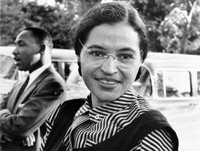 Having grown up under Jim Crow laws, Parks had long experienced racial segregation and inequality. African-American adults were permitted to ride in the “colored” section of buses and trains, but school bus transportation was not available at all for black children in the South. Parks recalled going to elementary school in Pine Level, Alabama, where buses took white students to their school while black students had to walk to their own school: “I’d see the bus pass every day… But to me, that was a way of life; we had no choice but to accept what was the custom. The bus was among the first ways I realized there was a black world and a white world.”
Having grown up under Jim Crow laws, Parks had long experienced racial segregation and inequality. African-American adults were permitted to ride in the “colored” section of buses and trains, but school bus transportation was not available at all for black children in the South. Parks recalled going to elementary school in Pine Level, Alabama, where buses took white students to their school while black students had to walk to their own school: “I’d see the bus pass every day… But to me, that was a way of life; we had no choice but to accept what was the custom. The bus was among the first ways I realized there was a black world and a white world.”
It is illuminating to juxtapose this early, dispiriting memory with a later, more encouraging one from the 1940s, during which Parks briefly worked at Maxwell Air Force Base, a federally-owned area where racial segregation was not allowed—and where she rode on an integrated trolley. As she put it: “You might just say Maxwell opened my eyes up.” Parks worked as a housekeeper and seamstress for a white, politically liberal couple, Clifford and Virginia Durr, who befriended her and helped her to attend the Highlander Folk School, an education center for workers’ rights and racial equality in Tennessee, in the summer of 1955, just months before the Montgomery bus incident.
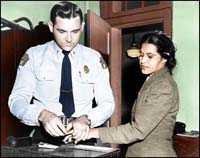 “I would have to know for once and for all what rights I had as a human being and a citizen,” Parks said, when she was later asked why she refused to give up her seat on December 1, 1955. Of her arrest, she said: “I only knew that, as I was being arrested, that it was the very last time that I would ever ride in humiliation of this kind.” Parks was charged with disorderly conduct and with a violation of Chapter 6, Section 11 segregation law of the Montgomery City code, even though she had not, technically, taken up a white-only seat—having been seated in a colored section.
“I would have to know for once and for all what rights I had as a human being and a citizen,” Parks said, when she was later asked why she refused to give up her seat on December 1, 1955. Of her arrest, she said: “I only knew that, as I was being arrested, that it was the very last time that I would ever ride in humiliation of this kind.” Parks was charged with disorderly conduct and with a violation of Chapter 6, Section 11 segregation law of the Montgomery City code, even though she had not, technically, taken up a white-only seat—having been seated in a colored section.
Edgar Daniel Nixon, an African American civil rights leader who was then the president of the Montgomery chapter of the NAACP, bailed Parks out of jail on the evening of December 2. He then consulted with Jo Ann Robinson, an Alabama State College professor and a member of the Women’s Political Council (WPC), about Parks’s case. Robinson stayed up all night mimeographing more than 35,000 handbills announcing a bus boycott, and the Women’s Political Council was the first group to officially endorse the boycott. Nixon then called several local ministers to organize further support for the boycott, one of whom was the young pastor, Dr. Martin Luther King, Jr., whose own rise to prominence as a civil rights leader was catalysed by his support of Rosa Parks.
The Montgomery Bus Boycott was expected to last only one day. Instead, it persisted for over a year, owing to the stamina of thousands of erstwhile passengers, African Americans who, in order to uphold the boycott, had to walk many miles to work and school, in all kinds of weather—and in spite of police coercion, fierce political opposition, and extreme personal threats. The number of bus passengers plummeted (75% of them had been African American), putting the bus company on the verge of financial ruin, and on February 1, 1956, bomb attacks were made on the homes of Martin Luther King and E.D. Nixon.
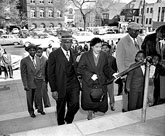 Meanwhile, Rosa Parks’ court challenge made its way through the court system until it reached the United States Supreme Court. On November 13, 1956, the U.S. Supreme Court struck down the Montgomery ordinance and outlawed racial segregation on public transportation. Rosa Parks became an international icon of resistance to racial segregation and the Montgomery Bus Boycott became the inspiration for decades of struggle for freedom and justice, both across the U.S. and internationally. (Upon his release from prison, Nelson Mandela told Parks: “You sustained me while I was in prison all those years.”)
Meanwhile, Rosa Parks’ court challenge made its way through the court system until it reached the United States Supreme Court. On November 13, 1956, the U.S. Supreme Court struck down the Montgomery ordinance and outlawed racial segregation on public transportation. Rosa Parks became an international icon of resistance to racial segregation and the Montgomery Bus Boycott became the inspiration for decades of struggle for freedom and justice, both across the U.S. and internationally. (Upon his release from prison, Nelson Mandela told Parks: “You sustained me while I was in prison all those years.”)
Although other courageous African-Americans before her had similarly refused to give up their seats, Rosa Parks’s quietly charismatic role at the heart of this historical and galvanizing campaign earned her recognition as “the first lady of civil rights” and “the mother of the freedom movement”. As Martin Luther King observed, Rosa Parks was a figure of great dignity, regarded as “one of the finest citizens of Montgomery—not one of the finest Negro citizens, but one of the finest citizens of Montgomery.”
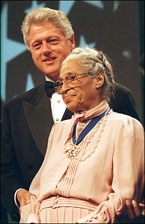 In 1957, Rosa Parks moved with her husband Raymond to Detroit, Michigan, where she served on the staff of African-American U.S. Representative John Conyers, while she and her husband continued their work with the NAACP, helping to improve the lives of African-Americans in the South. She also served on the board of the Planned Parenthood Federation of America. After her husband’s death in 1977, Parks founded the Rosa and Raymond Parks Institute for Self-Development, which sponsors an annual summer program for teenagers, Pathways to Freedom. (Students tour the U.S. in buses, learning the history of their country, including that of the civil rights movement.)
In 1957, Rosa Parks moved with her husband Raymond to Detroit, Michigan, where she served on the staff of African-American U.S. Representative John Conyers, while she and her husband continued their work with the NAACP, helping to improve the lives of African-Americans in the South. She also served on the board of the Planned Parenthood Federation of America. After her husband’s death in 1977, Parks founded the Rosa and Raymond Parks Institute for Self-Development, which sponsors an annual summer program for teenagers, Pathways to Freedom. (Students tour the U.S. in buses, learning the history of their country, including that of the civil rights movement.)
In 1996, President Clinton presented Rosa Parks with the Presidential Medal of Freedom and in 1999 she received a Congressional Gold Medal. Rosa Parks died in Detroit in 2005, at the age of 92. She is the only woman and the second African-American person in U.S. history to lie in state at the Capitol, an honor usually reserved for Presidents of the United States.
© Women’s WorldWide Web 2013













